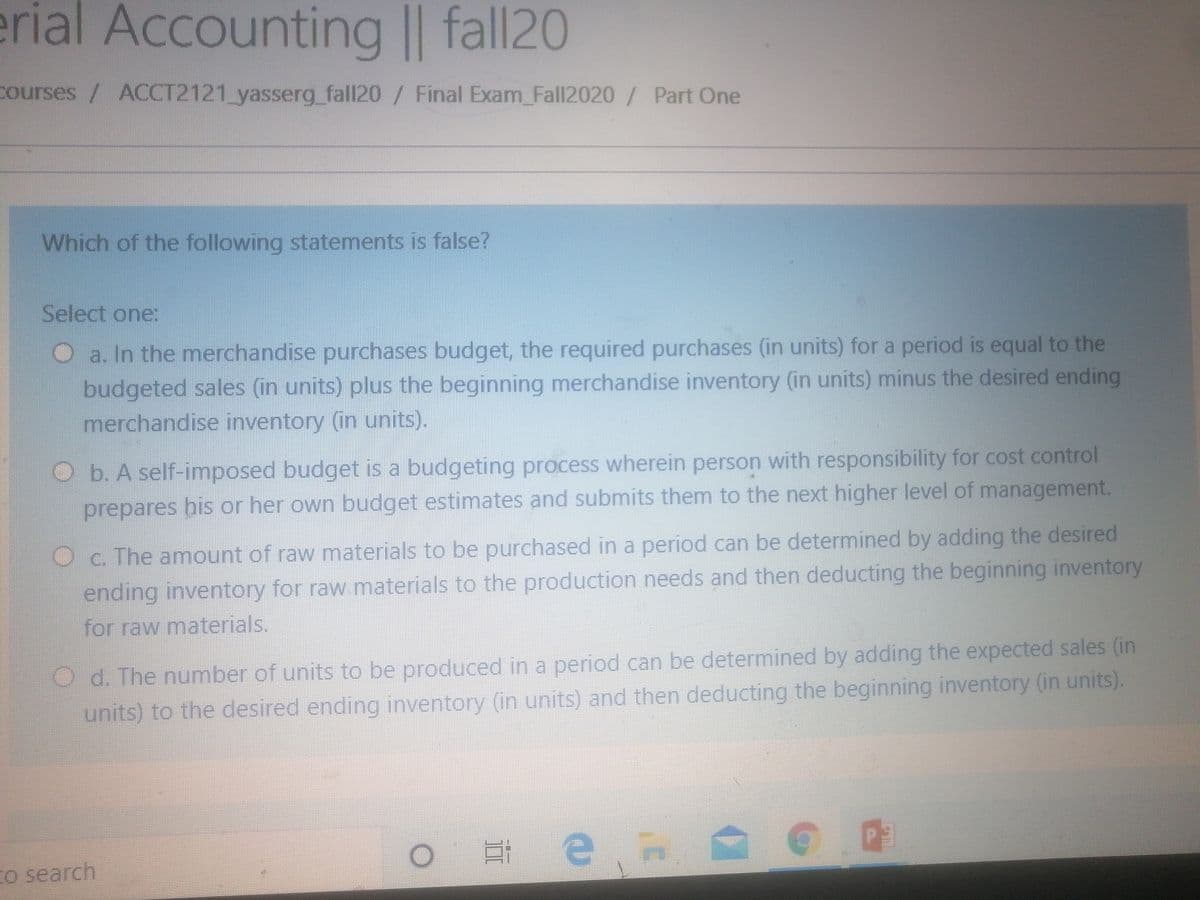erial Accounting || fall20 courses / ACCT2121 yasserg_fall20/ Final Exam_Fall2020 / Part One Which of the following statements is false? Select one: O a. In the merchandise purchases budget, the required purchases (in units) for a period is equal to the budgeted sales (in units) plus the beginning merchandise inventory (in units) minus the desired ending merchandise inventory (in units). Ob. A self-imposed budget is a budgeting process wherein person with responsibility for cost control prepares his or her own budget estimates and submits them to the next higher level of management. O c. The amount of raw materials to be purchased in a period can be determined by adding the desired ending inventory for raw materials to the production needs and then deducting the beginning inventory for raw materials. O d. The number of units to be produced in a period can be determined by adding the expected sales (in units) to the desired ending inventory (in units) and then deducting the beginning inventory (in units). Co search
erial Accounting || fall20 courses / ACCT2121 yasserg_fall20/ Final Exam_Fall2020 / Part One Which of the following statements is false? Select one: O a. In the merchandise purchases budget, the required purchases (in units) for a period is equal to the budgeted sales (in units) plus the beginning merchandise inventory (in units) minus the desired ending merchandise inventory (in units). Ob. A self-imposed budget is a budgeting process wherein person with responsibility for cost control prepares his or her own budget estimates and submits them to the next higher level of management. O c. The amount of raw materials to be purchased in a period can be determined by adding the desired ending inventory for raw materials to the production needs and then deducting the beginning inventory for raw materials. O d. The number of units to be produced in a period can be determined by adding the expected sales (in units) to the desired ending inventory (in units) and then deducting the beginning inventory (in units). Co search
Survey of Accounting (Accounting I)
8th Edition
ISBN:9781305961883
Author:Carl Warren
Publisher:Carl Warren
Chapter6: Receivables And Inventories
Section: Chapter Questions
Problem 6.5MBA: Lower of cost or market Using data in E6-18, indicate the effects of valuing inventory using lower...
Related questions
Topic Video
Question

Transcribed Image Text:erial Accounting || fall20
courses / ACCT2121_yasserg_fall20/ Final Exam_Fall2020/ Part One
Which of the following statements is false?
Select one:
O a. In the merchandise purchases budget, the required purchases (in units) for a period is equal to the
budgeted sales (in units) plus the beginning merchandise inventory (in units) minus the desired ending
merchandise inventory (in units).
Ob. A self-imposed budget is a budgeting process wherein person with responsibility for cost control
prepares bis or her own budget estimates and submits them to the next higher level of management.
Oc. The amount of raw materials to be purchased in a period can be determined by adding the desired
ending inventory for raw materials to the production needs and then deducting the beginning inventory
for raw materials.
O d. The number of units to be produced in a period can be determined by adding the expected sales (in
units) to the desired ending inventory (in units) and then deducting the beginning inventory (in units).
日e
to search
Expert Solution
This question has been solved!
Explore an expertly crafted, step-by-step solution for a thorough understanding of key concepts.
Step by step
Solved in 2 steps

Knowledge Booster
Learn more about
Need a deep-dive on the concept behind this application? Look no further. Learn more about this topic, accounting and related others by exploring similar questions and additional content below.Recommended textbooks for you

Survey of Accounting (Accounting I)
Accounting
ISBN:
9781305961883
Author:
Carl Warren
Publisher:
Cengage Learning

Survey of Accounting (Accounting I)
Accounting
ISBN:
9781305961883
Author:
Carl Warren
Publisher:
Cengage Learning